Volma
The Russian company Volma is another enterprise with almost a century of history. The forefather of the company was founded in 1943, the modern production as we know it today - in 1999. The company specializes in the production of materials and system solutions for construction and finishing works.
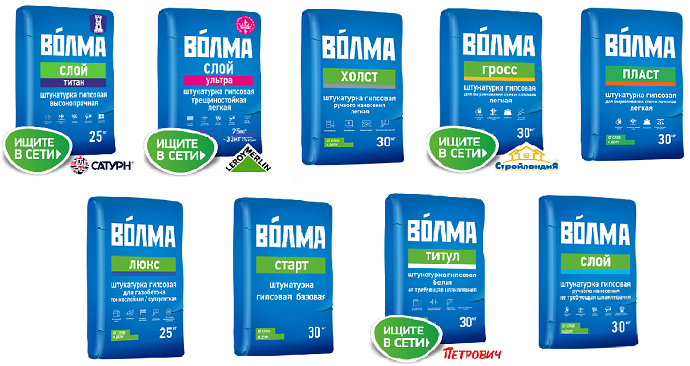
Product Features
Many of the mixtures considered allow you to get a coating that does not require a finishing putty. It will be glossy perfectly flat ceiling or walls for painting, wallpaper or decorative plaster. On one condition: strict adherence to the technology prescribed by the manufacturer. Which involves the use of proprietary primers, related materials and tools.
Among the products, you can choose a mixture with an increased viability of the finished solution. This figure can reach 2 hours, which is very convenient for preparing a large volume of mixture or for the work of a novice plasterer.
The shelf life of materials stored in unpacked bags in dry ventilated rooms is 1 year. This is 2 times more than that of Knauf.
All mixtures can only be used indoors with normal humidity and temperatures ranging from 5 to 30 ° C.
| Specifications | Layer Titanium | Layer Ultra | Canvas | Gross | Stratum |
|---|---|---|---|---|---|
| Application area | High strength, for walls and ceilings, on stone foundations, gypsum board and gypsum plasterboard. Gives a glossy surface that does not require filling. | Lightweight crack-resistant plaster for walls and ceilings made of concrete, brick, gas silicate blocks. No filling required. | Due to the lightweight filler, it can be applied in a thick layer to walls and ceilings of any rigid materials. | Composition with lightweight filler for walls and ceilings made of rigid materials. Requires finishing filler. | Analogous to the composition of Gross. The finished solution turns out to be more plastic due to modifying additives and less water consumption. |
| Consumption at a layer of 10 mm, kg / m² | 8-9 | 6-8 | 9-10 | 9-10 | 10 |
| Layer thickness min / max, mm | 5/100 | 2/30 | 5/50 | 5/30 | 5/30 |
| Viability, min. | 100 | 45 | 45 | 45 | 45 |
| Drying time (10 mm layer), days | 5-7 | 5-7 | 5-7 | 5-7 | 5-7 |
| Packing, kg | 25 | 25 | 30 | 30 | 25 and 30 |
| Cost, rub. | 290 | 300 | 280 | 270 | 230 (30 kg) |
| Coating cost with a thickness of 10 mm, rubles / m² | 93-104 | 72-96 | 84-93 | 81-90 | 77 |
Watch a short video to get an idea of the scale of production at this company.
| Specifications | MP 75 | MN Start | MP 75 Ultra |
|---|---|---|---|
| Application area | For plastering walls and ceilings on brick, concrete, etc. | For wall decoration. Suitable for hard types of substrates. | For thin and thick leveling of ceilings and walls. Suitable for stone types of bases. |
| Consumption at a layer of 10 mm, kg / m² | 8-9 | 10 | 9 |
| Layer thickness min / max, mm | on walls: 8/50 on ceiling: 8/15 | 10/30 | on walls: 2/60 on ceiling: 2/15 |
| Max size of fraction, mm | 1,2 | 1,2 | 1,2 |
| Drying time, days | 7 | 7 | 7 |
| Packing, kg | 30 | 30 | 30 |
| Cost, rub. | 275 | 240 | 300 |
| Coating cost with a thickness of 10 mm, rubles / m² | 73-83 | 80 | 90 |
| Specifications | Gips-Active | Gypsum-Active Extra |
|---|---|---|
| Application area | For rigid substrates on ceilings and walls, subject to prior priming. Does not require finishing filler. | Crack-resistant plaster for difficult substrates such as foam-aerated concrete walls, other rigid types of substrates. Requires careful selection of a primer. There is no need to putty on the finished coating. |
| Consumption with a layer of 10 mm, kg / m² | 8-9 | 7,5-8,5 |
| Layer thickness min / max, mm | 5/60 | 5/60 |
| Viability, min. | 90 | 120 |
| Drying time, days | 5-7 | 5-7 |
| Packing, kg | 30 | 30 |
| Cost, rub. | 240 | 250 |
| Coating cost with a thickness of 10 mm, rubles / m² | 64-72 | 63-71 |
Check out the three-minute commercial for Volma Layer, the manufacturer's most popular gypsum-based plaster mix.
Output: Volma products are not inferior in quality to Knauf. At the same time, the range and shelf life of mixtures is longer, which makes the choice more flexible and allows you to stretch the repair for a whole year.
Advantages
Volma is a popular manufacturer because the quality of its products pays off. The company offers a wide range, including several types of mixtures.
All brand putties have the following advantages:
- Environmentally friendly product. The building material can be used to level walls in different rooms, including a nursery. In its composition, harmful components are completely absent.
- The mixture is airy and pliable. It is a pleasure to work with putty, since leveling is very quick and easy.


- The putty gives the surface a beautiful appearance. There is no need to additionally use the finishing mixture.
- After using the building material, shrinkage is not carried out.
- The material is characterized by the ability to thermoregulate.
- To level the wall, it is enough to apply just one layer, which usually does not exceed a thickness of more than six centimeters.

- The material is characterized by the ability to thermoregulate.
- The mixture is durable, it also hardens quickly, which has a positive effect on the durability of the coating.
- The material can be used on a variety of surfaces.
- The inexpensive price of dry mixes and their long shelf life allows not only choosing a budget option, but also using the remains of the mix in the future.
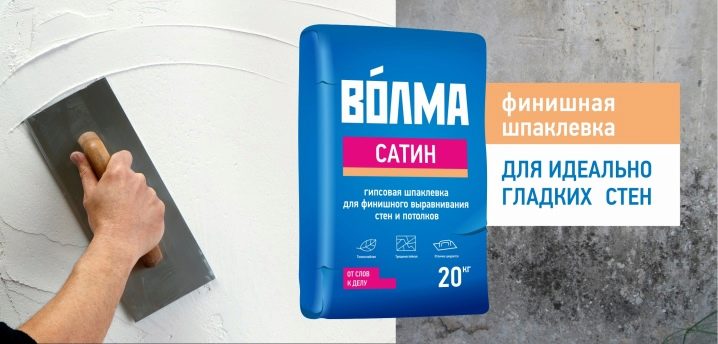
Gypsum plaster mix
So, the mixture in dry form is powdery and white, basically has:
- fine-grained gypsum;
- plasticizers;
- a number of polymer additives.
To obtain a ready-made mixture, builders simply need to add water. The ratio is also indicated on the packaging.
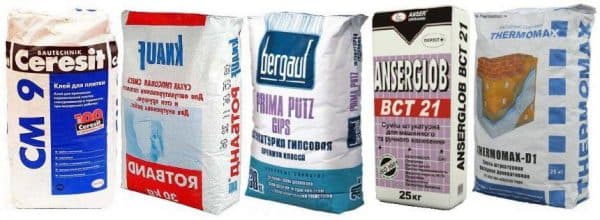
Gypsum plaster mix
The time for hardening varies from several minutes to half an hour, much depends on the percentage of gypsum in the mixture. This basis has a lot of advantages:
- environmentally friendly material;
- lasting;
- thermal stability;
- thermal conductivity.
If the walls of the building have strong irregularities, or a thick layer is required, then it is better to use plaster with internal reinforcement.

Internal reinforced plaster
It is worth appreciating the advantages and disadvantages of gypsum plaster.
The pluses include:
- perfectly aligns walls and blemishes after the end of the main work.
- the composition is without toxins, which means it is safe.
- perfectly protects against moisture and harmful fungi.
- due to the lightness of the mixture, even in diluted form, the consumption of plaster and the load is reduced, especially on load-bearing walls.
- excellent sound insulation and thermal conductivity. The question is especially relevant in multi-storey buildings.
- the material does not settle, therefore, as soon as it hardens, it is not prone to cracking.
- versatile material with excellent quality.
- material provides high finishing speed. The plaster hardens after three days, if the layer is not large. A thick layer of the mixture takes only a week.
- when finishing with plaster, a reinforced mesh is not required for better adhesion to the surface, even if the layer is thick, due to the plasticity and toughness of the material composition.
As for the negative traits:
- many may be repelled by the price of the material, but it is compensated by the economy of consumption and the speed of working with the mixture;
- not suitable for metal surfaces;
- finishing in bathrooms is also not recommended, unless of course you use moisture resistant plaster.
Advantages
Having analyzed the products of the Volma trademark, the experts have compiled a number of advantages. The positive aspects of the products were confirmed by professional craftsmen and ordinary buyers.
- The mixture is elastic and plastic. It is a light, airy composition.
- Volma putty is an environmentally friendly and safe material for health.
- This material has no shrinkage.
- Thermoregulation is inherent in this putty.
- It is distinguished by its convenient use and high quality.
- With its help, effective leveling is possible, as well as reliable sealing of joints.
- The maximum layer of material (in the process of leveling the base in one layer) is about 6 cm.
We have outlined the main advantages of the choice. The above-mentioned advantages are possessed only by certified, original goods.

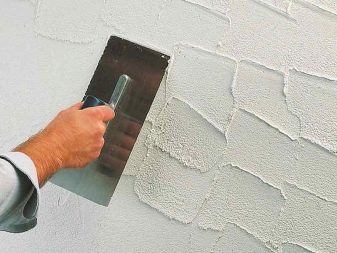
Which plaster to choose?
The choice of finishing mixture depends on the scope of work. What walls you will be plastering internal or external. The quality result always depends on the composition of the mixture. For interior decoration, gypsum mixture is most often used, and for exterior decoration there is no better cement. Find out how plaster differs from putty.

Cement plaster
But even among the mixtures there are varieties and they differ in additives and fillers, some are needed for better thermal insulation, others are moisture-proof.
Working efficiency is manifested:
- in increasing productivity during finishing work;
- the quality of finishing increases;
- the service life of the building is also significantly increased;
- repair costs are falling;
- moisture resistance increases;
- the strength of the finish;
- additives protect against fungal growth;
- increases grip on a variety of wall surfaces.
And this is only a small part of the advantages of various solutions that distinguish them from each other. The packages always describe the properties of all fillers inside.
So which plaster is better, gypsum or cement? The choice will depend on the type of work carried out during the repair period. Let's look at the properties of each and figure it out.
How to work properly with plaster?
From the mixtures described above, you can now judge for yourself which material is suitable for your work. For a rough finish, a cement base is ideal, it will help level out all the flaws that were made when laying the walls.
Of course, if you use structural plaster for interior use, the ideal material would be a gypsum base, which will provide preparation for finishing with decorative materials.
When choosing a future plaster for wall decoration, you need to clearly define the main points of the work:
- required layer;
- room humidity;
- the structure of the walls.
The mixtures can be used for manual and machine work. Carefully study the instructions and documentation of the building materials manufacturer. The finishing surface must be cleaned of imperfections and dirt;
If you need to apply several layers, then it is better to apply them gradually to avoid marriage. So which mix is better from plaster or cement? Each of them is suitable for certain jobs and is good in its own way. When making a choice, you should first decide where and which one is best.
Good luck with your repair or construction, carefully approach the selection and consumption of material, this will save you both money and time.
Cement base finishing
Cement has always been the most durable material, so it is often used not only in construction, but also in building decoration. A cement base will provide your home with:
- durability;
- strength;
- crack resistance;
- moisture resistance;
- plastic.
Cement plaster is often used in rooms with high humidity or vice versa in poorly heated rooms. The cement will provide strength due to its granular base. If you use a grid for wall decoration, then you can lay a thick layer of 5 cm. How many buckets fit in a 50 kg bag of cement. this link will tell.

Cement base finishing
Excellent for exterior decoration, due to its resistance to temperature extremes and weather changes.
Pros:
- the price is much lower than for gypsum;
- a similar mixture can be prepared at home using materials at hand;
- temperature resistance, as well as moisture;
- the mixture freezes for a long time, so you can work with it for a long time;
- environmental friendliness.
Disadvantages:
- does not adhere well to concrete;
- hard to work, too heavy material;
- does not apply to wood-based surfaces.
Cement plaster has been used for many centuries, so many builders trust this finishing material.
Application
Gypsum plaster is most often applied to brick and concrete walls or floors. It is more commonly used for interior decoration. On top of such a plaster, paint is perfectly applied.
You can also glue the wallpaper, just before final finishing it is necessary to dry the room well so that later the plaster does not swell and fall off.
Walls for which gypsum plaster is supposed to be used may have a different surface. For strongly curved walls, it is necessary to apply a liquid layer of plaster as the first layer, and after it dries, a thicker layer is applied.
Until the first layer of gypsum dries out, it is necessary to regularly apply the rule along the entire length of the applied layer in order to avoid the curvature of the future wall. If the surface is not very curved, then a thick mixture is prepared, while a thin layer is applied.
Views
There are many different types of gypsum plaster on the construction market. And each company offers its own unique product with its own unsurpassed properties. And often we get lost in such a rich choice. So how do you choose the best gypsum plaster for your walls?
The client can choose from various plaster from trusted firms:
KNAUF;
Volma;
Gipswell T-25;
Prospectors.
The main competitors in the construction market are two gypsum plaster companies, KNAUF and Volma. Which gypsum plaster is better than knauf or volma? Let's take a look at their merits.
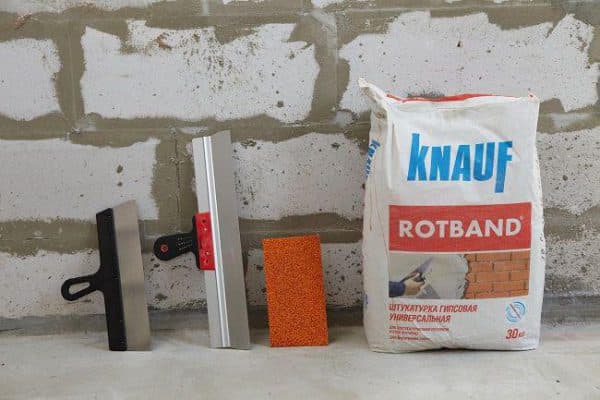
KNAUF Rotband
Due to them, the elasticity of the composition increases, and increases the service life. To ensure a smooth surface in the future, after drying the plaster, you need to moisten the wall with water and go through a float with a metal surface. This solution is water resistant, so it is great for a bathroom or toilet.
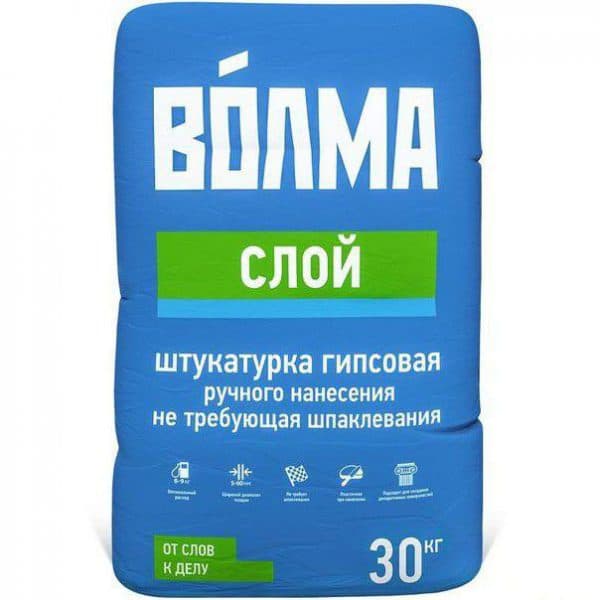
Volma
The solution is excellent for leveling walls before painting or wallpapering, as well as tiling.
What is the best price for gypsum plaster of the above:
- KNAUF - for a 30 kg bag 420 rubles;
- Volma - for a 30 kg bag 320 rubles.
Choose the best properties and composition of the gypsum mixture for the work you need.
Often builders are interested in what gypsum plasters are suitable for clay walls? Especially not professionals, because brick or concrete is a rather expensive material, and clay is more readily available. The problem of finishing clay walls is that if the material is incorrectly selected, the service life of the building can be reduced.
It is not recommended to apply paint to the finished finished wall, because cracks can form. It is better to glue the wallpaper afterwards.
